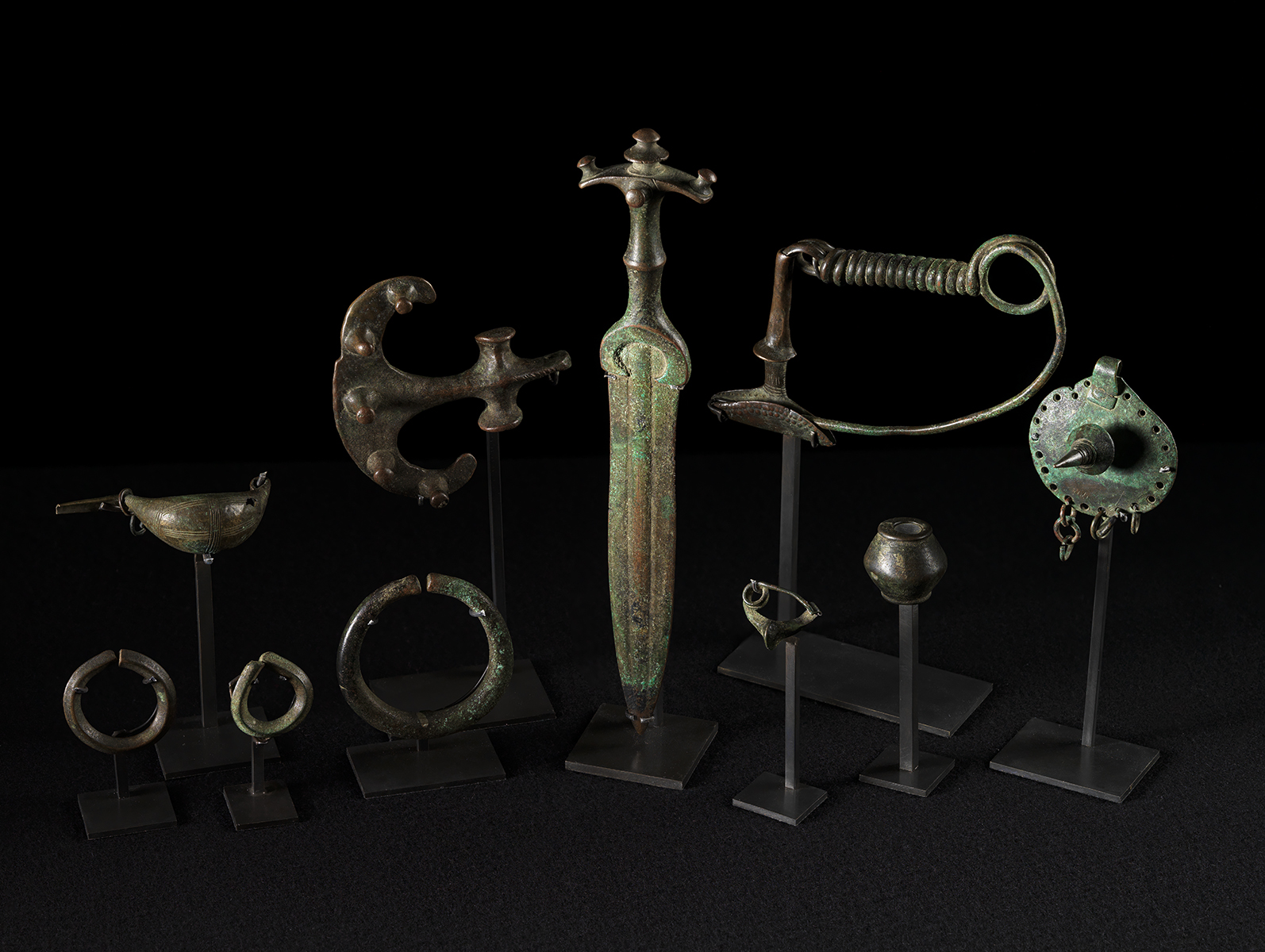Journal
The Artist as Collector: Jacob Epstein
Published 5/8/2025
Amlash Pottery
Published 5/6/2025
The Attraction of Abstract Idols
Published 5/7/2025
Corsican Bronzes: One-Way Track to the Past
Published 08/05/2025
Read time: 3min
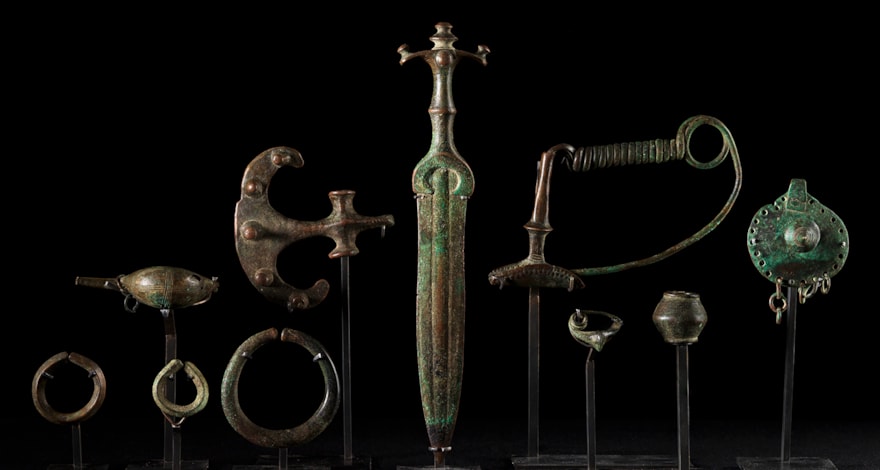
This collection of bronze implements were discovered at the same site on the bed of the Gravona river in Corsica around 1888-1890. They were found during the construction of the Ajaccio-Bastia railway line, which first opened in 1888. This enables us to pinpoint their location to one of two possible sites where the railway crosses the river: either in Carbuccia, 10 km north-east of Ajaccio, or at Bocognano, 10 km further in the same direction along the valley.
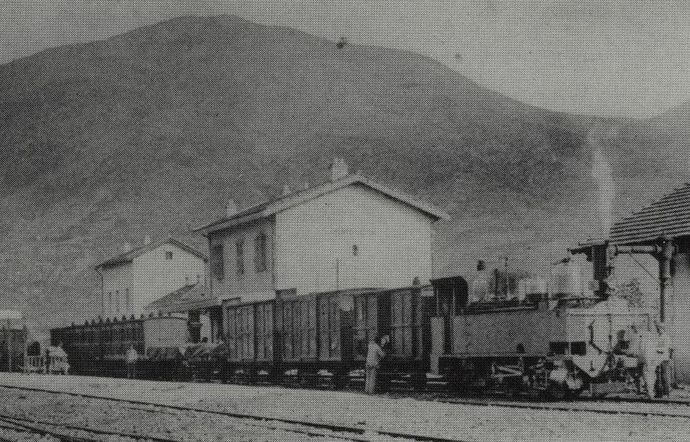
Connecting trains in Ponte-Leccia station. Mixed right for Ajaccio towed by a 031 Fives-Lille locomotive, circa 1882 (Collection J.RENAUD)
The group contains:
-one dagger
-one crescent-shaped bronze that may have been a belt-buckle
-one rounded pommel
-one disc with a projecting spike, which may have been part of a horses harness or brooch
-three bow fibulae (brooches) of various sizes
-three simple rings of differing sizes, possibly a form of proto-currency.
The style of these objects suggests a burial date of around 900 BCE. Then-director of the Musée préhistorique et gallo-romain in Strasbourg, Dr. Robert Forrer, published this group in an 8-page essay in the bulletin of the Société Préhistorique Française in 1924.
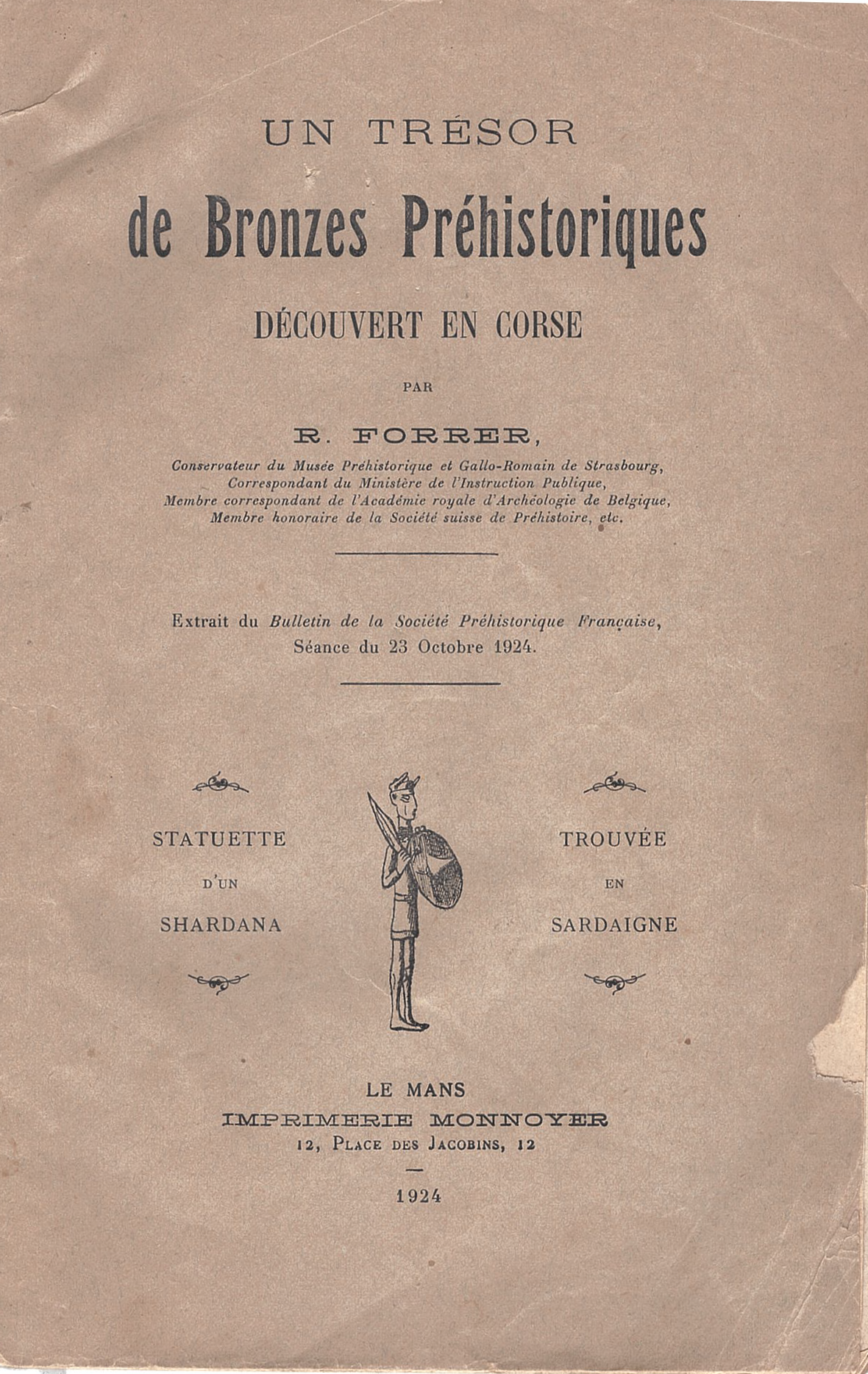
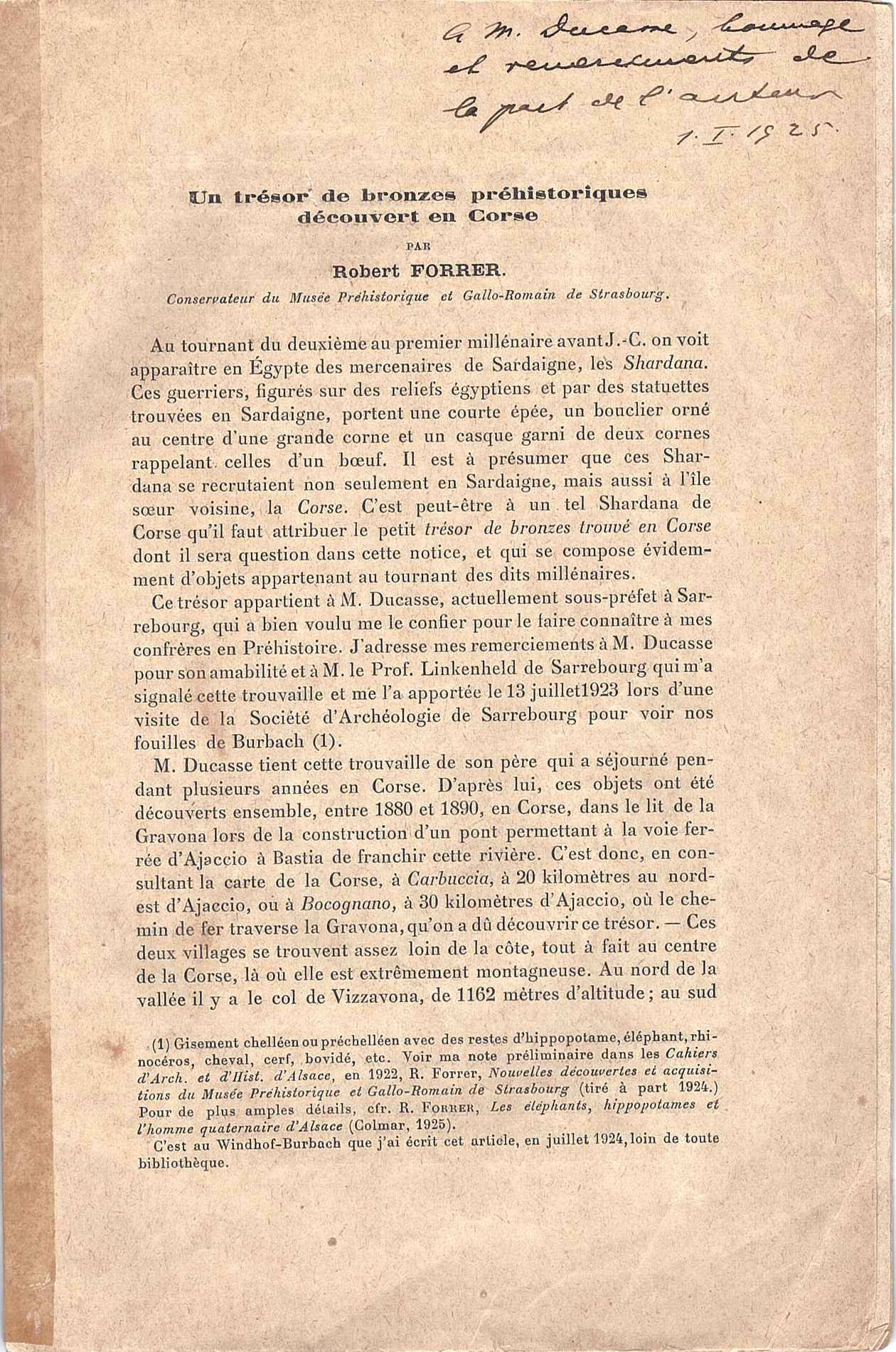
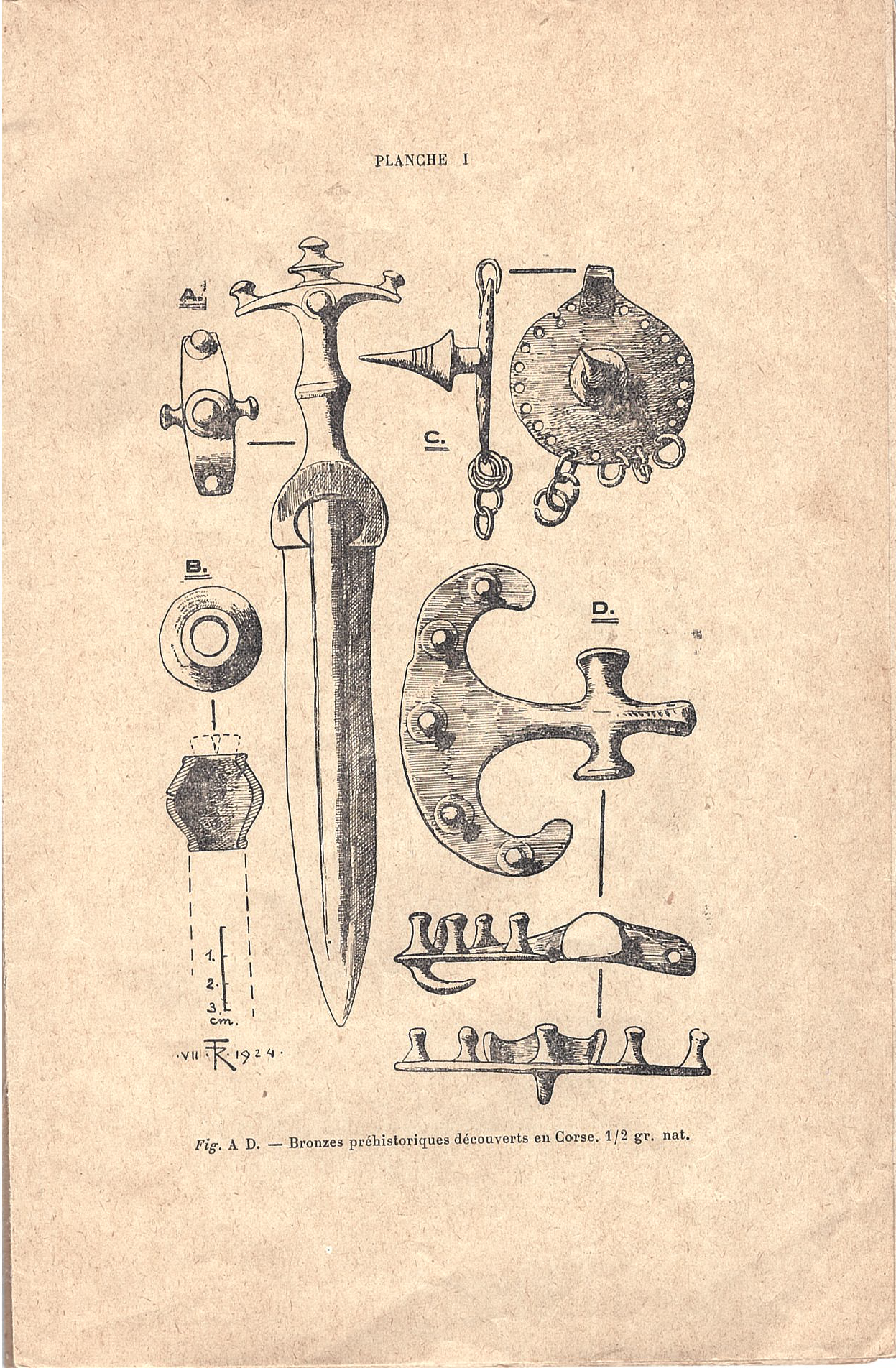
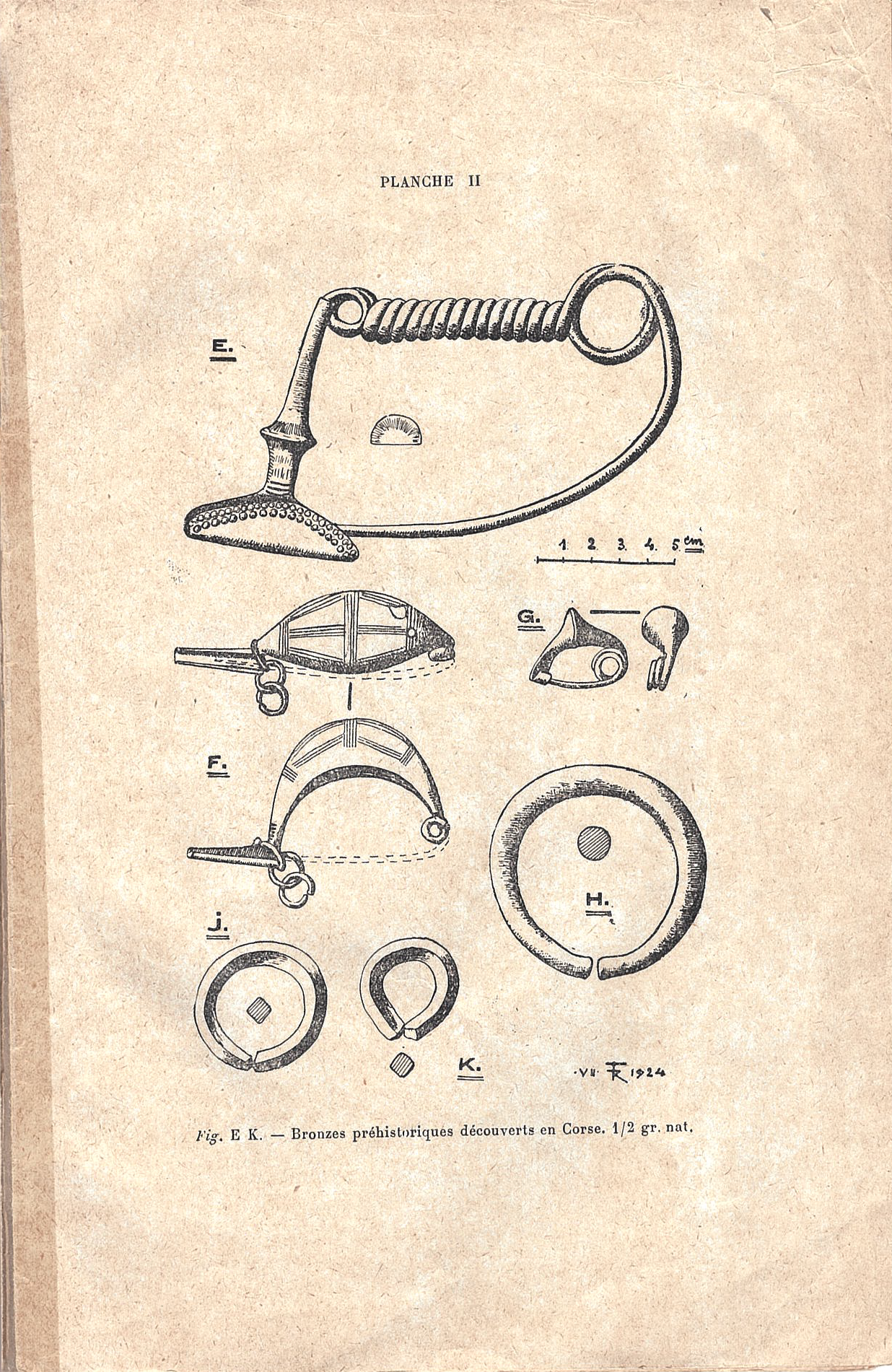
R Forrer, ‘Un trésor de bronzes préhistoriques decouvert en Corse’, Bulletin de la Société préhistorique de France, 10, 1924, pp. 224-232.
Why were these pieces buried together?
It is clear that these pieces were intentionally buried as a group by someone in ancient history. What is not clear is why. One theory is that they formed part of a funerary hoard, perhaps together with several other buried objects along the banks of the Gravona. Another is that they were a trader’s wares or a warrior’s treasure and were buried for safekeeping.
The two possible discovery sites along the river are both in inland mountainous regions. Forrer’s theory was that the bronzes were brought in from Sardinia, via Ajaccio and up the river, and were the property of a Sherden warrior. However, recent research indicates that the Torrean civilisation in the south of Corsica – previously thought to have begun in the second millennium B.C. when Sherden warriors landed on the island – was in fact an indigenous population. There is at least one confirmed example of the distinctive megalithic towers (torri) built by this civilisation in the Gravona valley, north-east of the capital. Therefore, these bronzes may have been produced near the discovery site.
What are they?
Some of the bronzes require no explanation, such as the dagger in typical late Bronze Age style, and the fibulae, which closely resemble similar brooches now in major museums.
Some of the pieces are, however, less easily understood. One is the crescent-shaped object adorned with five evenly-spaced raised round rivets, a short cross with rounded ends extends from the inner centre of the arc. The rivets and hook could have served as a means of affixing the bronze in place, suggesting that this object may have been a belt buckle, or perhaps part of a scabbard or horse harness.
Another is the circular disc, with a large, rounded spike projecting from its centre. This form resembles the shields held by warriors in Nuragic bronze statues, possibly linking the pieces to the Sardinian warriors from Forrer’s theory. Small holes are pierced around the circumference, four of which contain chain links, suggesting that this disc was previously part of a larger object. The disc may have been a phalera on a horse harness or perhaps the centrepiece of a brooch, as in a contemporaneous example in the Metropolitan Museum of Art, New York (2007.498.2).
The small pommel in the form of a hollow ovoid has one hole running through its length and another smaller hold at the side. These would allow a stick to be inserted through the pommel and held in place by a small nail, so that the pommel could be wielded as a part of a sceptre or other weapon. As it weighs in at a very light 69 grams, however, it seems most likely that the pommel would have been purely decorative – an ancient warrior wouldn’t have been able to do much damage with a 3.7 cm bronze!
Most puzzling are the three rings, each formed from a single bronze rod bent into a circle. Although they resemble Bronze Age bracelets from other sites, the largest is only 7.7 cm in diameter, and the others are much smaller, at 4.8 cm and 3.7 cm. These smallest two, would definitely not fit over anyone’s wrist. Forrer suggested one possible explanation of their purpose. He argued that, due to their simple forms and the relationships between their weights (the weight of the smallest is about 2/3 of the second smallest, which is approximately 1/4 of the largest), these rings may have been a form of currency, of the kind found in other Bronze Age settlements in Europe.
The Corsican Hoard raises many questions about the ancient society that produced it. We can only speculate as to who owned the pieces and why they were buried, and what purpose the bronzes served. Perhaps they hold the key to unravelling the secrets of Bronze Age Corsica.

Connecting trains in Ponte-Leccia station. Mixed right for Ajaccio towed by a 031 Fives-Lille locomotive, circa 1882 (Collection J.RENAUD)
The group contains:
-one dagger
-one crescent-shaped bronze that may have been a belt-buckle
-one rounded pommel
-one disc with a projecting spike, which may have been part of a horses harness or brooch
-three bow fibulae (brooches) of various sizes
-three simple rings of differing sizes, possibly a form of proto-currency.
The style of these objects suggests a burial date of around 900 BCE. Then-director of the Musée préhistorique et gallo-romain in Strasbourg, Dr. Robert Forrer, published this group in an 8-page essay in the bulletin of the Société Préhistorique Française in 1924.




R Forrer, ‘Un trésor de bronzes préhistoriques decouvert en Corse’, Bulletin de la Société préhistorique de France, 10, 1924, pp. 224-232.
Why were these pieces buried together?
It is clear that these pieces were intentionally buried as a group by someone in ancient history. What is not clear is why. One theory is that they formed part of a funerary hoard, perhaps together with several other buried objects along the banks of the Gravona. Another is that they were a trader’s wares or a warrior’s treasure and were buried for safekeeping.
The two possible discovery sites along the river are both in inland mountainous regions. Forrer’s theory was that the bronzes were brought in from Sardinia, via Ajaccio and up the river, and were the property of a Sherden warrior. However, recent research indicates that the Torrean civilisation in the south of Corsica – previously thought to have begun in the second millennium B.C. when Sherden warriors landed on the island – was in fact an indigenous population. There is at least one confirmed example of the distinctive megalithic towers (torri) built by this civilisation in the Gravona valley, north-east of the capital. Therefore, these bronzes may have been produced near the discovery site.
What are they?
Some of the bronzes require no explanation, such as the dagger in typical late Bronze Age style, and the fibulae, which closely resemble similar brooches now in major museums.
Some of the pieces are, however, less easily understood. One is the crescent-shaped object adorned with five evenly-spaced raised round rivets, a short cross with rounded ends extends from the inner centre of the arc. The rivets and hook could have served as a means of affixing the bronze in place, suggesting that this object may have been a belt buckle, or perhaps part of a scabbard or horse harness.
Another is the circular disc, with a large, rounded spike projecting from its centre. This form resembles the shields held by warriors in Nuragic bronze statues, possibly linking the pieces to the Sardinian warriors from Forrer’s theory. Small holes are pierced around the circumference, four of which contain chain links, suggesting that this disc was previously part of a larger object. The disc may have been a phalera on a horse harness or perhaps the centrepiece of a brooch, as in a contemporaneous example in the Metropolitan Museum of Art, New York (2007.498.2).
The small pommel in the form of a hollow ovoid has one hole running through its length and another smaller hold at the side. These would allow a stick to be inserted through the pommel and held in place by a small nail, so that the pommel could be wielded as a part of a sceptre or other weapon. As it weighs in at a very light 69 grams, however, it seems most likely that the pommel would have been purely decorative – an ancient warrior wouldn’t have been able to do much damage with a 3.7 cm bronze!
Most puzzling are the three rings, each formed from a single bronze rod bent into a circle. Although they resemble Bronze Age bracelets from other sites, the largest is only 7.7 cm in diameter, and the others are much smaller, at 4.8 cm and 3.7 cm. These smallest two, would definitely not fit over anyone’s wrist. Forrer suggested one possible explanation of their purpose. He argued that, due to their simple forms and the relationships between their weights (the weight of the smallest is about 2/3 of the second smallest, which is approximately 1/4 of the largest), these rings may have been a form of currency, of the kind found in other Bronze Age settlements in Europe.
The Corsican Hoard raises many questions about the ancient society that produced it. We can only speculate as to who owned the pieces and why they were buried, and what purpose the bronzes served. Perhaps they hold the key to unravelling the secrets of Bronze Age Corsica.






